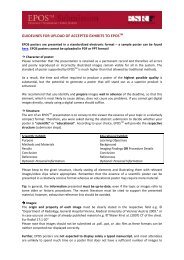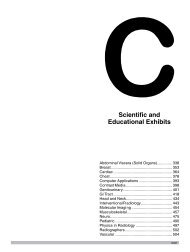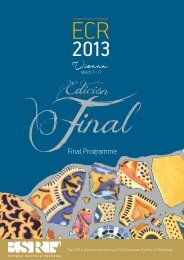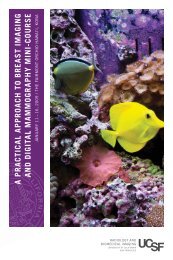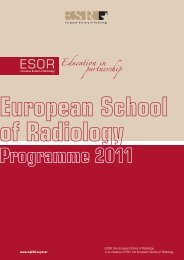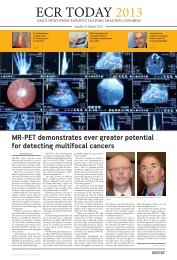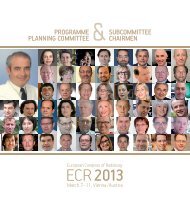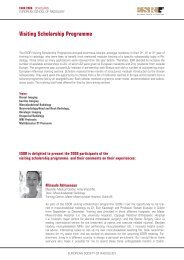New Horizons - myESR.org
New Horizons - myESR.org
New Horizons - myESR.org
- No tags were found...
You also want an ePaper? Increase the reach of your titles
YUMPU automatically turns print PDFs into web optimized ePapers that Google loves.
EUROPEAN CONGRESS OF RADIOLOGY 2013 | www.<strong>myESR</strong>.<strong>org</strong>Radiologists gatherto contemplate thefuture of MR/PETBy Mélisande RougerSaturday, March 9,08:30–10:00NH 8:MR/PET:a marriage made inheaven or hell?The field of possibilities offered by MR/PET is excitingbut remains unclear. Only a few machines are availableworldwide and very little information exists about this newhybrid modality. Research is ongoing, but it is still too earlyto produce results. Always at the forefront of innovation, theECR will feature a special <strong>New</strong> <strong>Horizons</strong> Session to presentdelegates with the prospects, potential and requirementsof MR/PET in neurological and oncologic imaging, nextMarch in Vienna.MR/PET is a completely new technology, introduced about two years ago. As such, it requiresclinical evaluation and raises many questions regarding its value, explained session chairmanProfessor Bernd Hamm, director of the Institute of Radiology at the Charité University Hospitalin Berlin.“The questions are: in which indication will we have a benefit, and how big will these benefitsbe? In other words, is MR/PET just a very expensive new toy without real medical benefits or doesit offer completely new diagnostic insights that would improve the treatment of patients?” he said.Sequential imaging of both modalities already provides very good morphological and metabolicinformation. MR is considered to have the best contrast resolution in cross-sectional imaging; itprovides a lot of anatomical detail, and offers the option of measuring parameters of perfusion,cell density and metabolism, while PET allows the study of metabolic changes with sensitivityin the picomolar range. The information from MR and PET images is highly valuable in manyfields, including oncologic, cardiovascular and neurological imaging.So why would a combination of MR with PET be of value? Many arguments speak in favourof such a union. One such argument is that it could improve tumour detection, by allowing thevisualisation of a lesion through both morphological and metabolic images with unrivalledsensitivity. Professor Heinz-Peter Schlemmer, head of the radiology department at the GermanCancer Research Centre, has worked extensively on comparative studies with whole-body MRand PET/CT for the detection of solid tumours. He found that, while all modalities are useful forthis task, depending on the particular tumour entities, MR and PET have the highest accuracy.“Interestingly the important information came either from MR or PET studies, but CT wasoften not that relevant. We thought that the combination of PET and MR would be ideal to detectand typify tumours. Locally, the tumour can be imaged with the best anatomical resolution byMR, and in addition you have this metabolic and membrane receptor information about cellsfrom PET, so together you increase your sensitivity and specificity for tumour detection andcharacterisation,” he said.30ECR 2013 | Preliminary Programme EdiciÓn Invierno




